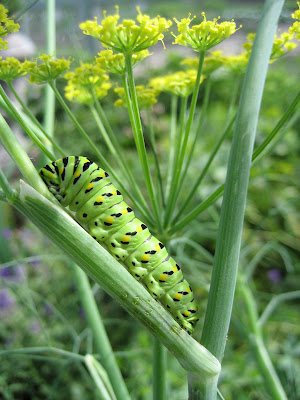
I got alotta fennel goin' on. There is a good reason for that.
Fennel is a relative of a huge plant family, the Apiaceae, known colloquially as umbellifers. The latter name refers to the morphological form of the flower, the umbel.
Whew. Whatever, right? Mmm, no. Since I'm writing about it, you should know about it.
Fennel is lovely for exactly 3 reasons:
- It tastes damn good
- Those umbel flowers attracts beneficial insects
- Is a primary food source for Black Swallowtail larvae!!!
- Oh, yeah, #4: it reads as a fuzzy and airy mass from a distance when planted in beds, the thin foliage can be bright green or bronze, it collects dew on moist mornings, and it smells like the best kind of licorice . . .
Let's get back to the umbel now that you know more about where I am going with this. The umbel may seem like it is just one big, dome-shaped flower. Go ahead, bend down, check it out, it won't bite. That umbel is a compound flower that is made up of hundreds of branched florets. It is those tiny flowers that make up what you are looking at.
(Trip into my brain: Did anyone see the Sensation exhibit from the Saatchi Collection at the Brooklyn Museum of Art back in '00? When I first walked into the space, to my immediate right, there hung a huge portrait of British child murderer, Myra Hindley. Marcus Harvey painted Myra's maniacal monochrome visage from her arrest photo using children's hand prints dipped in black and white paint. Anyway, that reminds me of an umbel. Think about it.)
Welcome back. So those miniature flowers are the BEST food for the BEST kind of insects you want in your garden. Teeny parasitoid wasps and other beneficials feed off the nectar that is profusely produced from the umbel flowers.

It is these wasps and flies that will go out an attack the aphids, cabbage loopers, tomato hornworms, and all the other nasties that invade our garden spaces. Have I stressed enough the importance of planting lots of umbel flowers within your vegetable gardens and perennial borders? This is called attracting beneficial insects, a very savvy gardening philosophy. This is the first step in my personal integrated pest management protocol: I get to know my adversaries, and I staunchly promote their enemies. Or, you can just think of it as "plant it and they will come".
Another benefit of this particular umbel is a benevolent one. This quiet garden visitor means no harm, does no damage, and is truly thrilling to behold in all its stages of life.

The larvae of the black swallowtail butterfly also loves the taste of fennel. In early August I found 4!, yes 4! of these stunning larvae on one plant!

I got a little macro-happy . . .

So I can only wonder where these glow worms are now.
Have their wings dried? Are they sipping the late-season nectar of Eupatorium purpureum and Aster divaricatus? I am just pleased to have observed them preparing themselves for their reincarnation.


Your posts never cease to amaze me. Another fantastic read!
ReplyDeleteGreat pics!
ReplyDelete